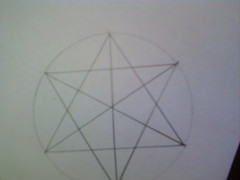
After we had admired our work for a little bit Jojo then asked us if we knew how many line segments there were inside of our circle. After many failed attempts to answer the question Jojo then gave us the formula we needed to find out how many interior angles were inside of the circle.
The sum of interior angles= 180(n-2)
If you look at the Polygon Table On PBworks then you would find the pattern that is shown within the table. Every polygon's # of inscribed triangles is two less than the amount of its # of sides. In the formula the n represents the # of sides on a polygon.
Then we created another star in the second circle this time we were not allowed to intersect the lines. This was proven difficult so instead we just created the star how we did the first time and erased the parts where the line was intersected.

Then we did problem #19 in Chapter 4 on pg 56 in our math workbook. The problem states
"In a certain isosceles triangle, the smallest angle has a measure of 28 degrees. What are the measures of the two largest angles?" While answering this problem we kept in mind the new tip about dealing with isosceles triangles,
"When solving isosceles triangles we can assume three different scenarios will occur unless the given angle is stated as a the smallest or the largest. Then there is only one possible answer for the missing angles."
When solving this problem we knew that Isosceles triangles have at least two sides and that we already have a side given that states that it is the smallest angle, therefore we know the other two sides of this triangle are equal. Thus, we are able to say both variables in place for the missing measurements can be expressed as x=y
When we set up our problem we were also able to use to x's in our eqaution because x=y.
First step- 28+x+x=180
We set up the problem like this because we know that all sides of a triangle equal 180 therefore we must set our variables and our given measurment equal to 180.
Second step- 2x=152
We must had like terms and subtract 28 from both sides.
Third Step (solve)- x=76
Today's SCRIBE IS JERICHOOOO!!!




This comment has been removed by the author.
ReplyDeleteHey Charles, Jericho isn't on the scribe list anymore...
ReplyDeleteSomeone may want to remind Charles to Label his post scribe post!
ReplyDelete